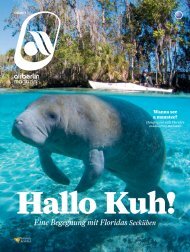Erfolgreiche ePaper selbst erstellen
Machen Sie aus Ihren PDF Publikationen ein blätterbares Flipbook mit unserer einzigartigen Google optimierten e-Paper Software.
<strong>airberlin</strong> <strong>magazin</strong> 3 / <strong>2015</strong> 81<br />
In Sleeping Bear<br />
country<br />
Traverse City and the Sleeping Bear Dunes National Lakeshore<br />
are just a five-hour drive from Chicago. Once an insider tip,<br />
this area is now one of the most popular tourist destinations<br />
in the USA.<br />
t would be a great quiz question: which inland beach was<br />
voted the “Most Beautiful Beach” in the USA? The answer:<br />
the beach of the Sleeping Bear Dunes National Lakeshore<br />
on Lake Michigan, one of the five Great Lakes – and there<br />
are over thirty miles of it to enjoy. What’s more, a survey by the<br />
TV breakfast show “Good Morning America” named the dunes of<br />
this national park the “Most Beautiful Place in America” by some<br />
considerable margin, ahead of even the Grand Canyon.<br />
We approach the Sleeping Bear Dunes National Lakeshore on<br />
the Empire Bluff Trail. After a hike of three-quarters of a mile<br />
under a green canopy of beech and maple trees, we finally reach<br />
the shoreline, where we’re treated to a spectacular view. Lake<br />
Michigan extends out to the west like an ocean, its opposite bank<br />
way beyond the horizon. Below us, the steep, almost chiselled<br />
coastline curves away in a northerly direction, its white sand<br />
covering the contours of the ground like icing on a cake. It’s an<br />
unexpected sight to come across in densely wooded Michigan.<br />
John, one of the park rangers in charge of protecting the natural<br />
habitat of the dunes, tells us how the wildly romantic Sleeping<br />
Bear Dunes National Lakeshore in the north-west of Michigan<br />
came by its name: “It harks back to an Anishinabe or Ojibwa<br />
Indian legend. A mother bear and her two young cubs were driven<br />
into Lake Michigan by a forest fire. She made it to the shore, but<br />
her cubs were too weak to swim far, and sadly drowned. Once<br />
she gained dry land, the grieving mother lay down on the shore<br />
to wait for them. Many years passed, and the winds gradually<br />
blew more and more sand on top of the bear until only her outline<br />
remained visible. But the Great Spirit Manitou hadn’t forgotten<br />
her. He created North and South Manitou Islands to mark the<br />
spots in the water where the cubs had met their death: they’re<br />
both visible in fine weather. A giant solitary dune on the shore<br />
represents the cubs’ mother – but it’s shrinking every year.” John<br />
points it out: “Admittedly it takes a fair bit of imagination to make<br />
out the shape of a bear.”<br />
The Great Lakes were created during the last Ice Age some<br />
ten thousand years ago, while the sand dunes are a mere two<br />
thousand years old. They tower over one hundred and forty<br />
metres above the water. This quirk of nature, until recently an<br />
insider tourist tip, is now a popular mini-break destination. It’s a<br />
five-hour drive from Chicago to the Sleeping Bear Dunes National<br />
Lakeshore and the sandy beach on the banks of Lake Michigan.<br />
We resist the temptation to clamber over the dunes down to<br />
the shoreline. Getting to the water wouldn‘t be a problem, but


















